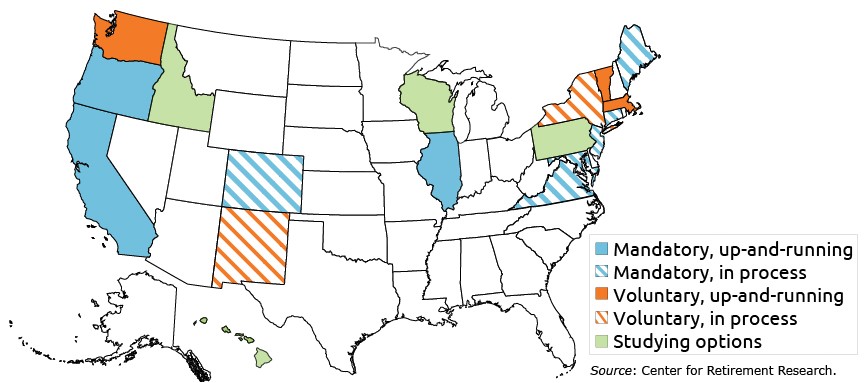
State Auto-IRAs are Building Momentum
About half of the nation’s private-sector employees do not have a retirement savings plan at work, and that hasn’t changed in at least 40 years.
Some states are trying to fix this coverage gap in the absence of substantial progress by the federal government in solving the problem. And the state reforms are gaining momentum.
 In the past year alone, Maine, Virginia, and Colorado have passed bills requiring private employers without a retirement plan to automatically enroll their workers in IRAs, with workers allowed to opt out. New York City, which is more populous than most states, approved its program in May. And other states are either starting to implement programs or looking at their options.
In the past year alone, Maine, Virginia, and Colorado have passed bills requiring private employers without a retirement plan to automatically enroll their workers in IRAs, with workers allowed to opt out. New York City, which is more populous than most states, approved its program in May. And other states are either starting to implement programs or looking at their options.
Auto-IRAs are already up and running in California, Illinois, and Oregon, where a total of nearly 360,000 workers have saved more than $270 million so far. The programs are run by a private sector administrator and investment manager.
These mandatory programs are the only practical way to close the coverage gap, because voluntary retirement saving initiatives have never done the trick. Numerous voluntary plans created by the federal government – such as the Simplified Employee Pension (SEP) – have failed to measurably increase coverage.
Large corporations usually offer a 401(k) plan and match some of their workers’ savings. But millions of restaurants, shops, and other small businesses either can’t afford to set up their own 401(k)s or don’t see it as a priority. Without additional saving, half of U.S. workers are at risk of a drop in their standard of living when they retire.
State auto-IRA programs eliminate the administrative burden and expense to employers of a private plan and provide an easy way for workers to save. The money is taken out of their paychecks before they can spend it and is deposited in an account that grows over time. The state programs also permit workers to withdraw their contributions without a tax penalty for emergencies, like a medical problem or broken-down car, if they need the money they’ve saved.
A federal program would probably be better than a myriad of state programs, but in the meantime millions of workers are being offered a way to save.
Squared Away writer Kim Blanton invites you to follow us on Twitter @SquaredAwayBC. To stay current on our blog, please join our free email list. You’ll receive just one email each week – with links to the two new posts for that week – when you sign up here. This blog is supported by the Center for Retirement Research at Boston College.






